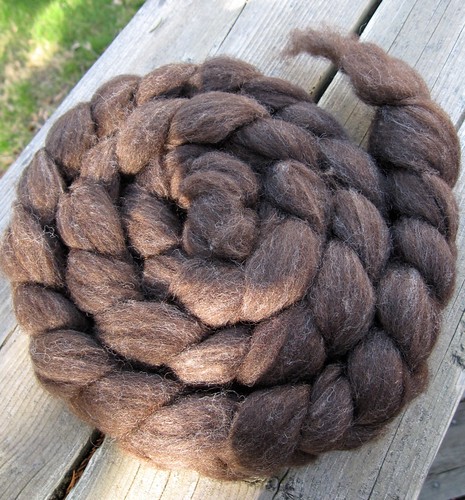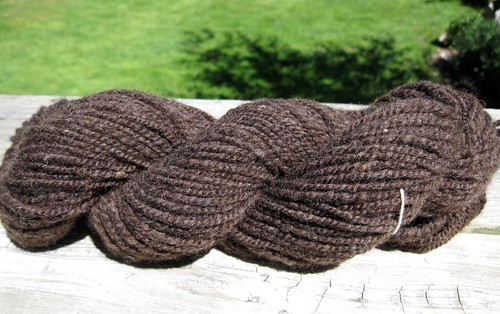So yesterday, I was plying up some yarn that I made with Coopworth roving. It is a lovely dark, rich brown.
I bought it because a) I wanted to practice supported long draw (see Abby Franquemont's video here), which is best done with roving, and b) it's lovely and soft. In that respect, it's a way better version of the Coopworth fleece I bought at the Vermont Sheep and Wool Festival, which is so coarse that no matter how I process it, and no matter how I spin it, I can't seem to make a yarn that I would want to spend any time knitting:
Anyway, I was finding this roving a little, well, challenging. Mostly because I'm not so good at supported long draw. I'm way too much of a control freak, and you pretty much have to abandon yourself to the twist and let it do what it's going to do. And what it's going to do—at least, if you're me—is pull the fiber out of the supply hand in a somewhat uneven way. And, since I'm a control freak, this makes me a little crazy. Did I mention that I'm a control freak?
Compounding what I have come to think of as my long draw problem is the fact that this roving has some of what spinners call "VM"—vegetable matter—in it. Mostly this is little bits of hay. So I'm spinning along, trying to get into some kind of rhythm with the long draw, and having to keep stopping to pick out the hay, which is surprisingly tenacious. Suffice to say, I found this a less than entirely relaxing experience.
So last night I plied about half of it, and I wasn't happy. It just didn't look good. It was uneven. It was fuzzy, and not in a way I liked. But, hearing Abby Franquemont's voice in my head, from her video on drafting, saying that woolen yarns change a lot when they are washed, I dutifully went downstairs to my basement, where the yarn washing happens, and fulled the heck out of that yarn, using the method Judith McKenzie McCuin describes in Teach Yourself Visually Handspinning. In other words, I felted the yarn a bit to give it more structure, help the plies cohere, and encourage the fiber to puff up and take up more space. I soaked it in hot water and Eucalan for a bit, then moved it to very cold water to shock it, then back to hot. Then I agitated it with a sink plunger (brilliant, Judith) purchased for the purpose. Then back to cold. Etc. Then, as usual, I wrapped it in a towel and spun the water out using the spin cycle of my washing machine, gave it a few good smacks against the stainless steel surface of my laundry folding table, and put my hands through the loop of the skein and snapped it a few times, a la Maggie Casey. The last two steps are said to distribute the twist.
Suddenly, I loved this yarn. I loved the way it felt, and looked, and smelled. It's still quite "rustic," but it's also soft and lovely and bouncy. And much more even in diameter than I expected.
And then I had two thoughts.
Thought Number One: this is why I spin. Because even though I disliked picking out all the little bits of hay, this is a much nicer, livelier yarn because the fiber has been so minimally processed. It still smells a tiny bit sheepy (in a good way). It's a little tweedy because it hasn't been carded to within an inch of its life to blend the colors. And it's bouncy in a way that most commercial yarn isn't, because most commercial yarn has been made from wool that has been through a process that literally burns the VM out of the fiber. It really is a different creature from commercial yarn.
Thought Number Two: fulling is a pretty good metaphor for life. You're all ugly and uneven and imperfect and full of little bits of hay. Then you get beaten up--tossed from hot to cold, agitated with a plunger, smacked against a table. And then it turns out, after all that, that the abuse has smoothed you out, rendered you shiny and resilient. You're still imperfect, yes, and you're beautiful.







Yeah
ReplyDeleteIt's so true! I struggled with my first VM-laden Coopworth and figured it was a bad batch of fibre. Then I watched Abby's video and a little light came on. I used longdraw for it (a technique I couldn't wrap my mind around before either), then wet finished it as you did, and wow; what a great yarn. And like you, I love the sheepy, tweedy character of it.
ReplyDeleteI enjoy your podcast. We started spinning at the same time, so I find it interesting to see the parallels between our progress.